Managerial Accounting Assignment: Costing and Pricing Strategies
VerifiedAdded on 2021/04/17
|6
|1057
|43
Homework Assignment
AI Summary
This assignment solution addresses a managerial accounting problem involving two chemicals, X-14 and S-17, produced by South Pacific Chemicals. The core of the assignment involves comparing the traditional costing method with Activity-Based Costing (ABC) to accurately allocate overhead costs. The student computes plantwide overhead rates, direct labor hours per unit, and overhead costs per unit under both methods. The analysis reveals that the traditional costing system over-allocates overhead costs to X-14 and under-allocates them to S-17. The solution then uses ABC to re-evaluate costs, calculate gross margins, and recommend pricing strategies. Based on the ABC system, the assignment suggests that the company reduce the price of X-14 and increase the price of S-17 to improve its competitive position and profitability. The solution also includes relevant references supporting the concepts discussed.
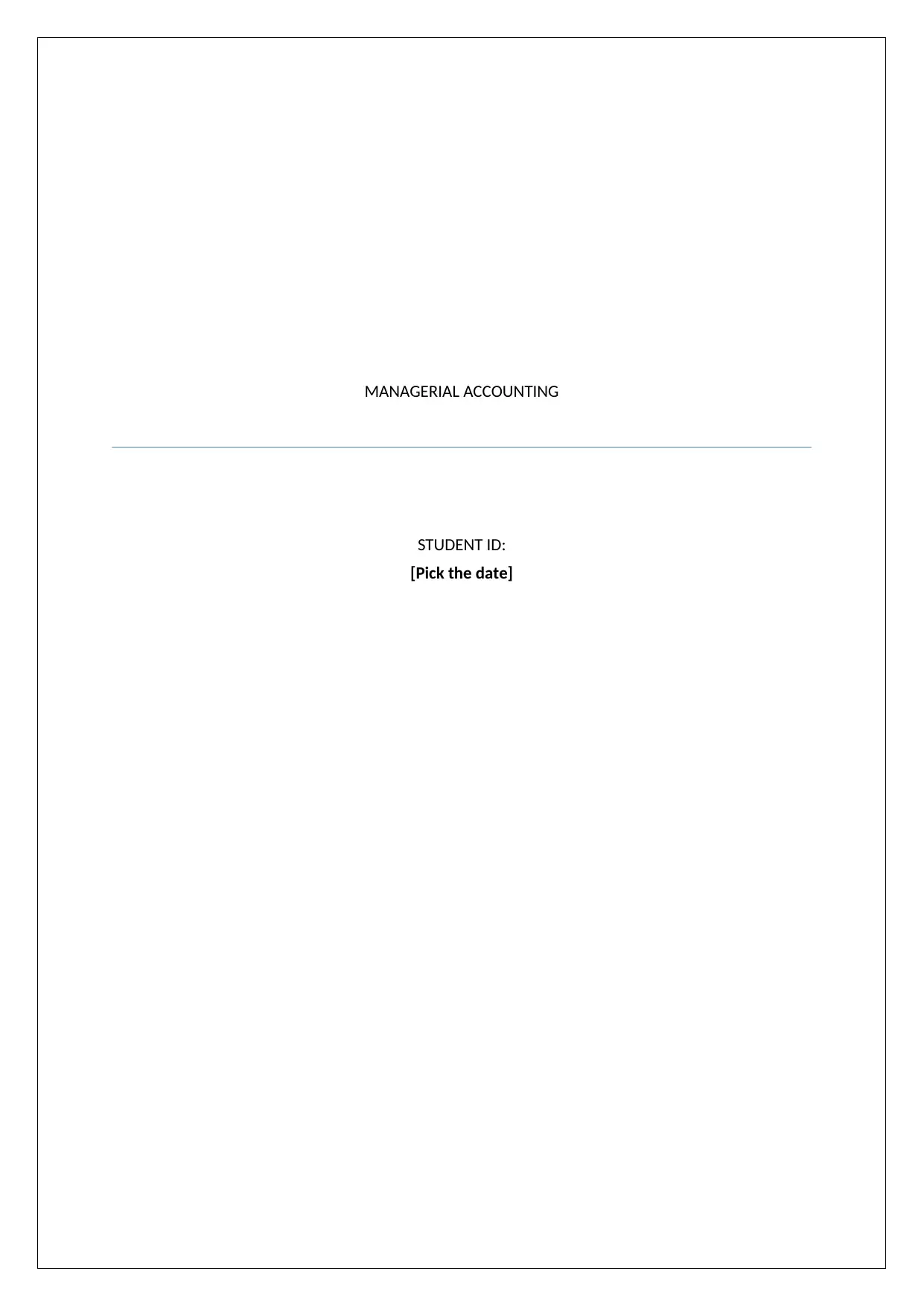
MANAGERIAL ACCOUNTING
STUDENT ID:
[Pick the date]
STUDENT ID:
[Pick the date]
Paraphrase This Document
Need a fresh take? Get an instant paraphrase of this document with our AI Paraphraser
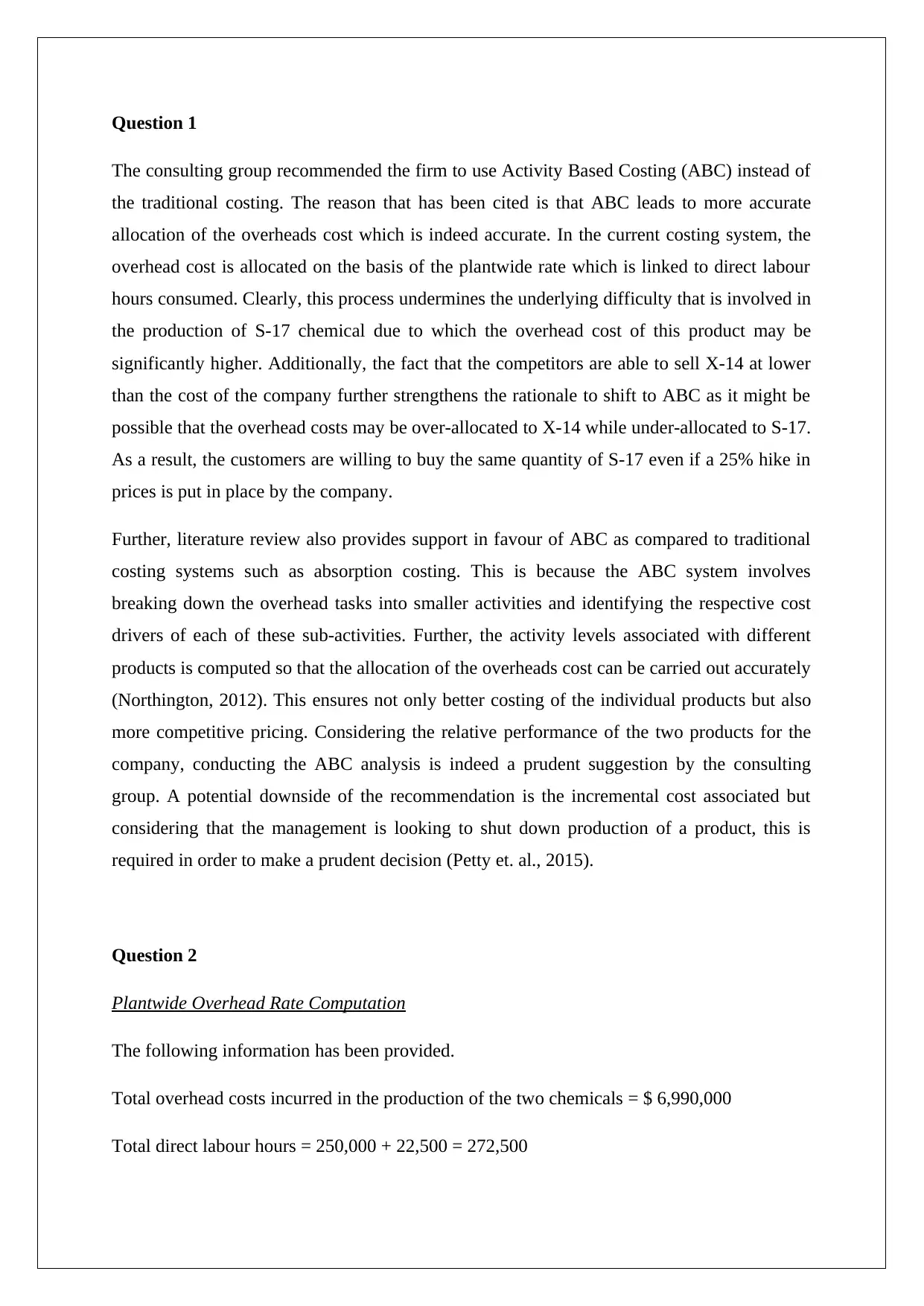
Question 1
The consulting group recommended the firm to use Activity Based Costing (ABC) instead of
the traditional costing. The reason that has been cited is that ABC leads to more accurate
allocation of the overheads cost which is indeed accurate. In the current costing system, the
overhead cost is allocated on the basis of the plantwide rate which is linked to direct labour
hours consumed. Clearly, this process undermines the underlying difficulty that is involved in
the production of S-17 chemical due to which the overhead cost of this product may be
significantly higher. Additionally, the fact that the competitors are able to sell X-14 at lower
than the cost of the company further strengthens the rationale to shift to ABC as it might be
possible that the overhead costs may be over-allocated to X-14 while under-allocated to S-17.
As a result, the customers are willing to buy the same quantity of S-17 even if a 25% hike in
prices is put in place by the company.
Further, literature review also provides support in favour of ABC as compared to traditional
costing systems such as absorption costing. This is because the ABC system involves
breaking down the overhead tasks into smaller activities and identifying the respective cost
drivers of each of these sub-activities. Further, the activity levels associated with different
products is computed so that the allocation of the overheads cost can be carried out accurately
(Northington, 2012). This ensures not only better costing of the individual products but also
more competitive pricing. Considering the relative performance of the two products for the
company, conducting the ABC analysis is indeed a prudent suggestion by the consulting
group. A potential downside of the recommendation is the incremental cost associated but
considering that the management is looking to shut down production of a product, this is
required in order to make a prudent decision (Petty et. al., 2015).
Question 2
Plantwide Overhead Rate Computation
The following information has been provided.
Total overhead costs incurred in the production of the two chemicals = $ 6,990,000
Total direct labour hours = 250,000 + 22,500 = 272,500
The consulting group recommended the firm to use Activity Based Costing (ABC) instead of
the traditional costing. The reason that has been cited is that ABC leads to more accurate
allocation of the overheads cost which is indeed accurate. In the current costing system, the
overhead cost is allocated on the basis of the plantwide rate which is linked to direct labour
hours consumed. Clearly, this process undermines the underlying difficulty that is involved in
the production of S-17 chemical due to which the overhead cost of this product may be
significantly higher. Additionally, the fact that the competitors are able to sell X-14 at lower
than the cost of the company further strengthens the rationale to shift to ABC as it might be
possible that the overhead costs may be over-allocated to X-14 while under-allocated to S-17.
As a result, the customers are willing to buy the same quantity of S-17 even if a 25% hike in
prices is put in place by the company.
Further, literature review also provides support in favour of ABC as compared to traditional
costing systems such as absorption costing. This is because the ABC system involves
breaking down the overhead tasks into smaller activities and identifying the respective cost
drivers of each of these sub-activities. Further, the activity levels associated with different
products is computed so that the allocation of the overheads cost can be carried out accurately
(Northington, 2012). This ensures not only better costing of the individual products but also
more competitive pricing. Considering the relative performance of the two products for the
company, conducting the ABC analysis is indeed a prudent suggestion by the consulting
group. A potential downside of the recommendation is the incremental cost associated but
considering that the management is looking to shut down production of a product, this is
required in order to make a prudent decision (Petty et. al., 2015).
Question 2
Plantwide Overhead Rate Computation
The following information has been provided.
Total overhead costs incurred in the production of the two chemicals = $ 6,990,000
Total direct labour hours = 250,000 + 22,500 = 272,500
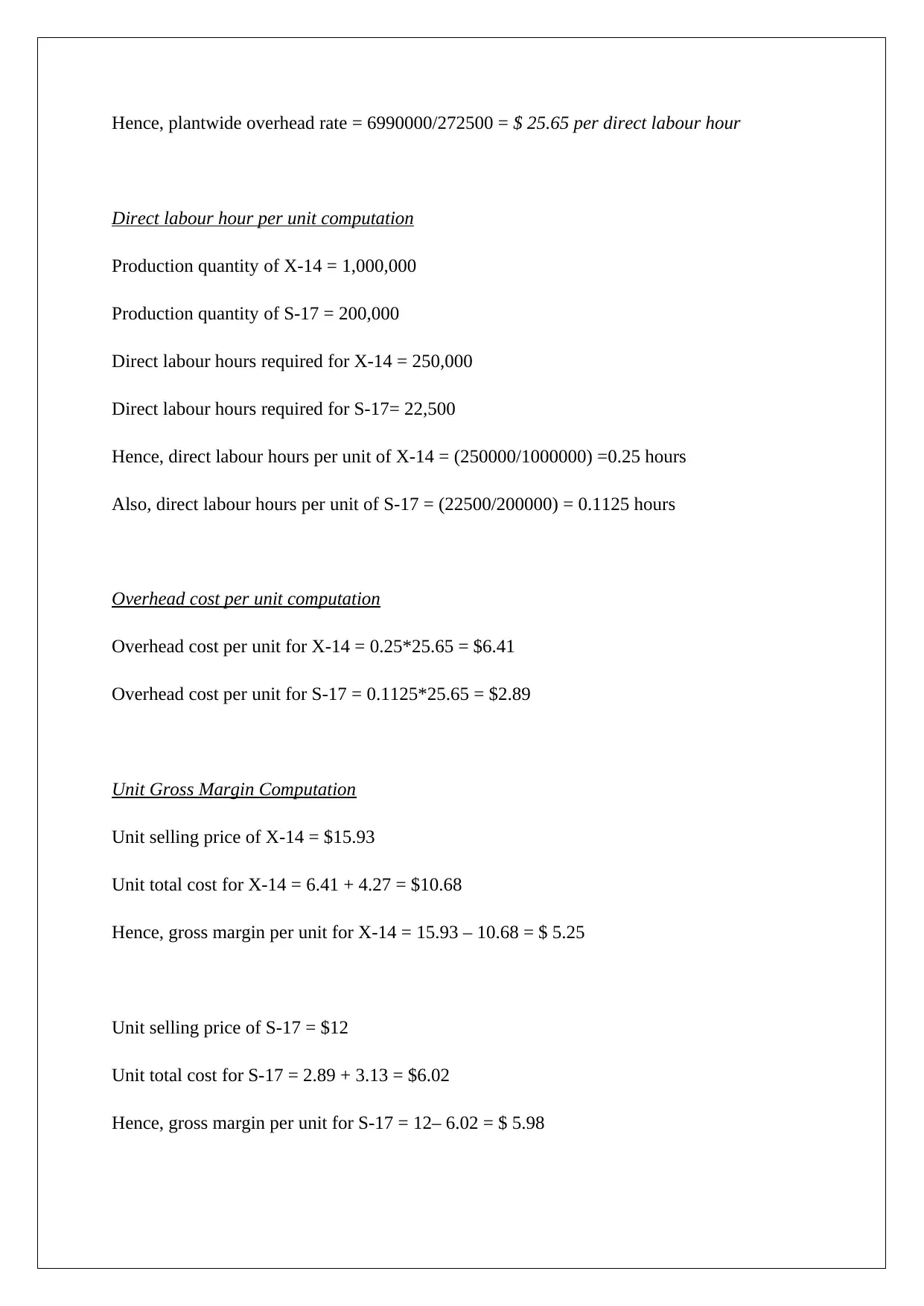
Hence, plantwide overhead rate = 6990000/272500 = $ 25.65 per direct labour hour
Direct labour hour per unit computation
Production quantity of X-14 = 1,000,000
Production quantity of S-17 = 200,000
Direct labour hours required for X-14 = 250,000
Direct labour hours required for S-17= 22,500
Hence, direct labour hours per unit of X-14 = (250000/1000000) =0.25 hours
Also, direct labour hours per unit of S-17 = (22500/200000) = 0.1125 hours
Overhead cost per unit computation
Overhead cost per unit for X-14 = 0.25*25.65 = $6.41
Overhead cost per unit for S-17 = 0.1125*25.65 = $2.89
Unit Gross Margin Computation
Unit selling price of X-14 = $15.93
Unit total cost for X-14 = 6.41 + 4.27 = $10.68
Hence, gross margin per unit for X-14 = 15.93 – 10.68 = $ 5.25
Unit selling price of S-17 = $12
Unit total cost for S-17 = 2.89 + 3.13 = $6.02
Hence, gross margin per unit for S-17 = 12– 6.02 = $ 5.98
Direct labour hour per unit computation
Production quantity of X-14 = 1,000,000
Production quantity of S-17 = 200,000
Direct labour hours required for X-14 = 250,000
Direct labour hours required for S-17= 22,500
Hence, direct labour hours per unit of X-14 = (250000/1000000) =0.25 hours
Also, direct labour hours per unit of S-17 = (22500/200000) = 0.1125 hours
Overhead cost per unit computation
Overhead cost per unit for X-14 = 0.25*25.65 = $6.41
Overhead cost per unit for S-17 = 0.1125*25.65 = $2.89
Unit Gross Margin Computation
Unit selling price of X-14 = $15.93
Unit total cost for X-14 = 6.41 + 4.27 = $10.68
Hence, gross margin per unit for X-14 = 15.93 – 10.68 = $ 5.25
Unit selling price of S-17 = $12
Unit total cost for S-17 = 2.89 + 3.13 = $6.02
Hence, gross margin per unit for S-17 = 12– 6.02 = $ 5.98
⊘ This is a preview!⊘
Do you want full access?
Subscribe today to unlock all pages.

Trusted by 1+ million students worldwide
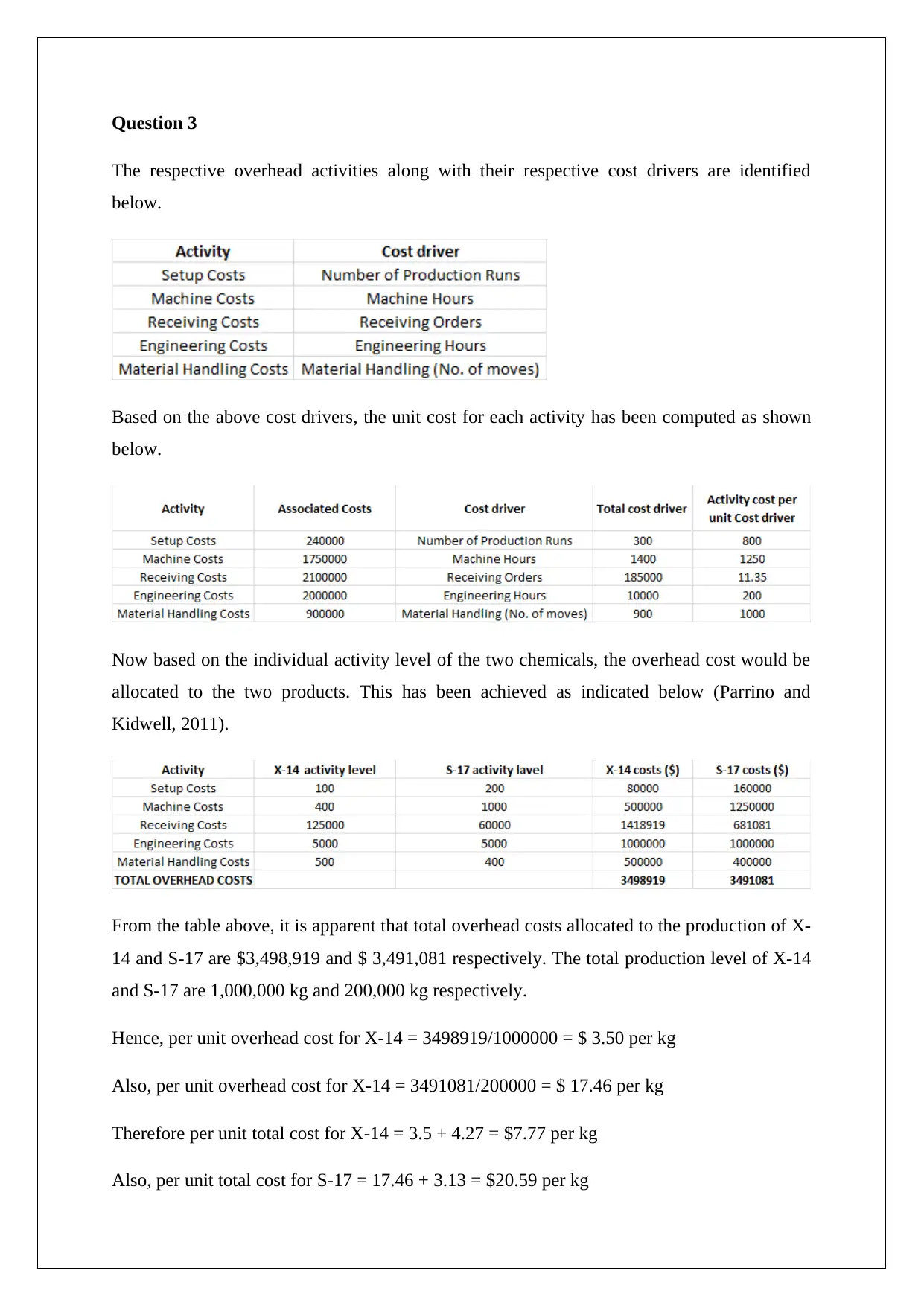
Question 3
The respective overhead activities along with their respective cost drivers are identified
below.
Based on the above cost drivers, the unit cost for each activity has been computed as shown
below.
Now based on the individual activity level of the two chemicals, the overhead cost would be
allocated to the two products. This has been achieved as indicated below (Parrino and
Kidwell, 2011).
From the table above, it is apparent that total overhead costs allocated to the production of X-
14 and S-17 are $3,498,919 and $ 3,491,081 respectively. The total production level of X-14
and S-17 are 1,000,000 kg and 200,000 kg respectively.
Hence, per unit overhead cost for X-14 = 3498919/1000000 = $ 3.50 per kg
Also, per unit overhead cost for X-14 = 3491081/200000 = $ 17.46 per kg
Therefore per unit total cost for X-14 = 3.5 + 4.27 = $7.77 per kg
Also, per unit total cost for S-17 = 17.46 + 3.13 = $20.59 per kg
The respective overhead activities along with their respective cost drivers are identified
below.
Based on the above cost drivers, the unit cost for each activity has been computed as shown
below.
Now based on the individual activity level of the two chemicals, the overhead cost would be
allocated to the two products. This has been achieved as indicated below (Parrino and
Kidwell, 2011).
From the table above, it is apparent that total overhead costs allocated to the production of X-
14 and S-17 are $3,498,919 and $ 3,491,081 respectively. The total production level of X-14
and S-17 are 1,000,000 kg and 200,000 kg respectively.
Hence, per unit overhead cost for X-14 = 3498919/1000000 = $ 3.50 per kg
Also, per unit overhead cost for X-14 = 3491081/200000 = $ 17.46 per kg
Therefore per unit total cost for X-14 = 3.5 + 4.27 = $7.77 per kg
Also, per unit total cost for S-17 = 17.46 + 3.13 = $20.59 per kg
Paraphrase This Document
Need a fresh take? Get an instant paraphrase of this document with our AI Paraphraser
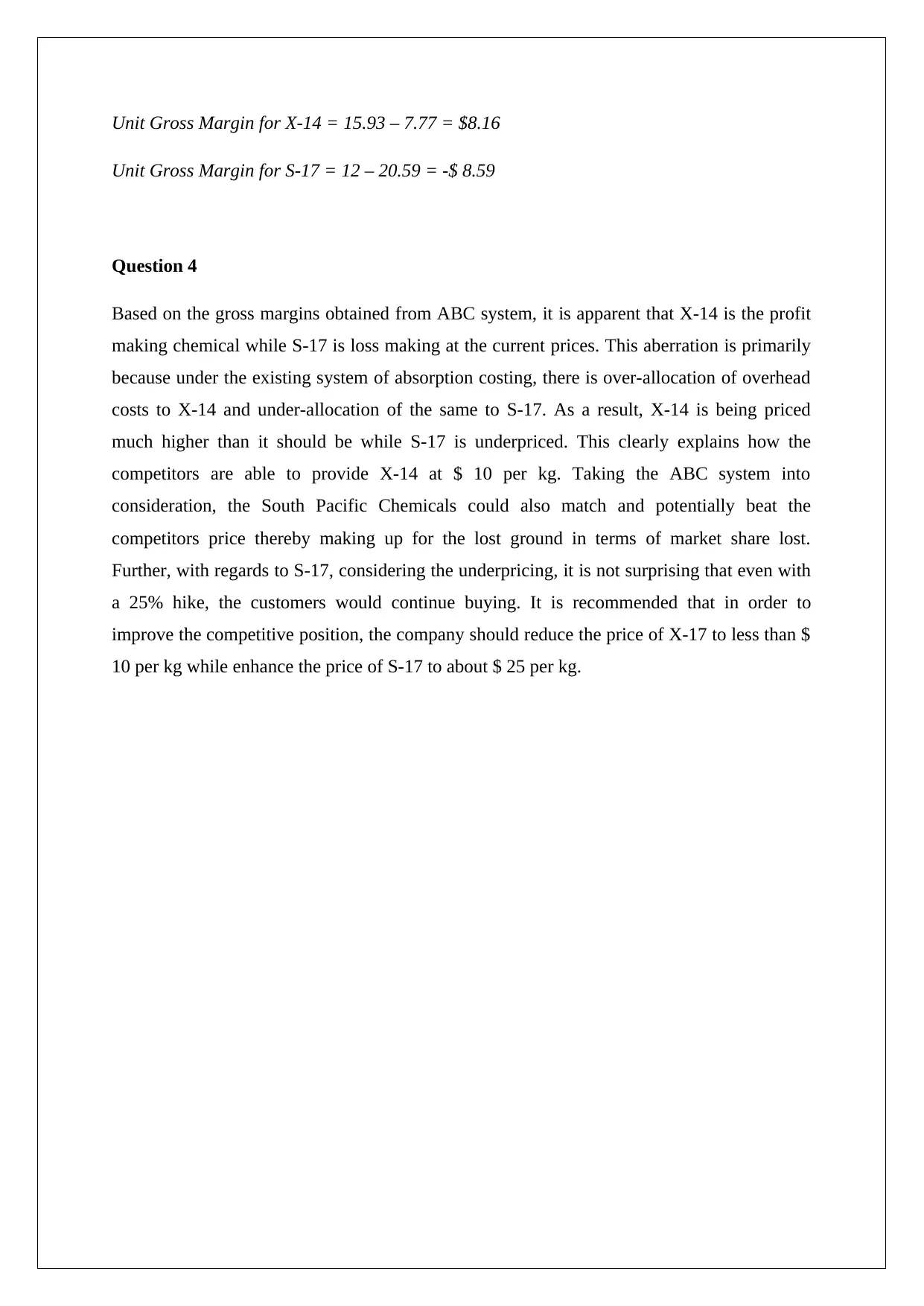
Unit Gross Margin for X-14 = 15.93 – 7.77 = $8.16
Unit Gross Margin for S-17 = 12 – 20.59 = -$ 8.59
Question 4
Based on the gross margins obtained from ABC system, it is apparent that X-14 is the profit
making chemical while S-17 is loss making at the current prices. This aberration is primarily
because under the existing system of absorption costing, there is over-allocation of overhead
costs to X-14 and under-allocation of the same to S-17. As a result, X-14 is being priced
much higher than it should be while S-17 is underpriced. This clearly explains how the
competitors are able to provide X-14 at $ 10 per kg. Taking the ABC system into
consideration, the South Pacific Chemicals could also match and potentially beat the
competitors price thereby making up for the lost ground in terms of market share lost.
Further, with regards to S-17, considering the underpricing, it is not surprising that even with
a 25% hike, the customers would continue buying. It is recommended that in order to
improve the competitive position, the company should reduce the price of X-17 to less than $
10 per kg while enhance the price of S-17 to about $ 25 per kg.
Unit Gross Margin for S-17 = 12 – 20.59 = -$ 8.59
Question 4
Based on the gross margins obtained from ABC system, it is apparent that X-14 is the profit
making chemical while S-17 is loss making at the current prices. This aberration is primarily
because under the existing system of absorption costing, there is over-allocation of overhead
costs to X-14 and under-allocation of the same to S-17. As a result, X-14 is being priced
much higher than it should be while S-17 is underpriced. This clearly explains how the
competitors are able to provide X-14 at $ 10 per kg. Taking the ABC system into
consideration, the South Pacific Chemicals could also match and potentially beat the
competitors price thereby making up for the lost ground in terms of market share lost.
Further, with regards to S-17, considering the underpricing, it is not surprising that even with
a 25% hike, the customers would continue buying. It is recommended that in order to
improve the competitive position, the company should reduce the price of X-17 to less than $
10 per kg while enhance the price of S-17 to about $ 25 per kg.
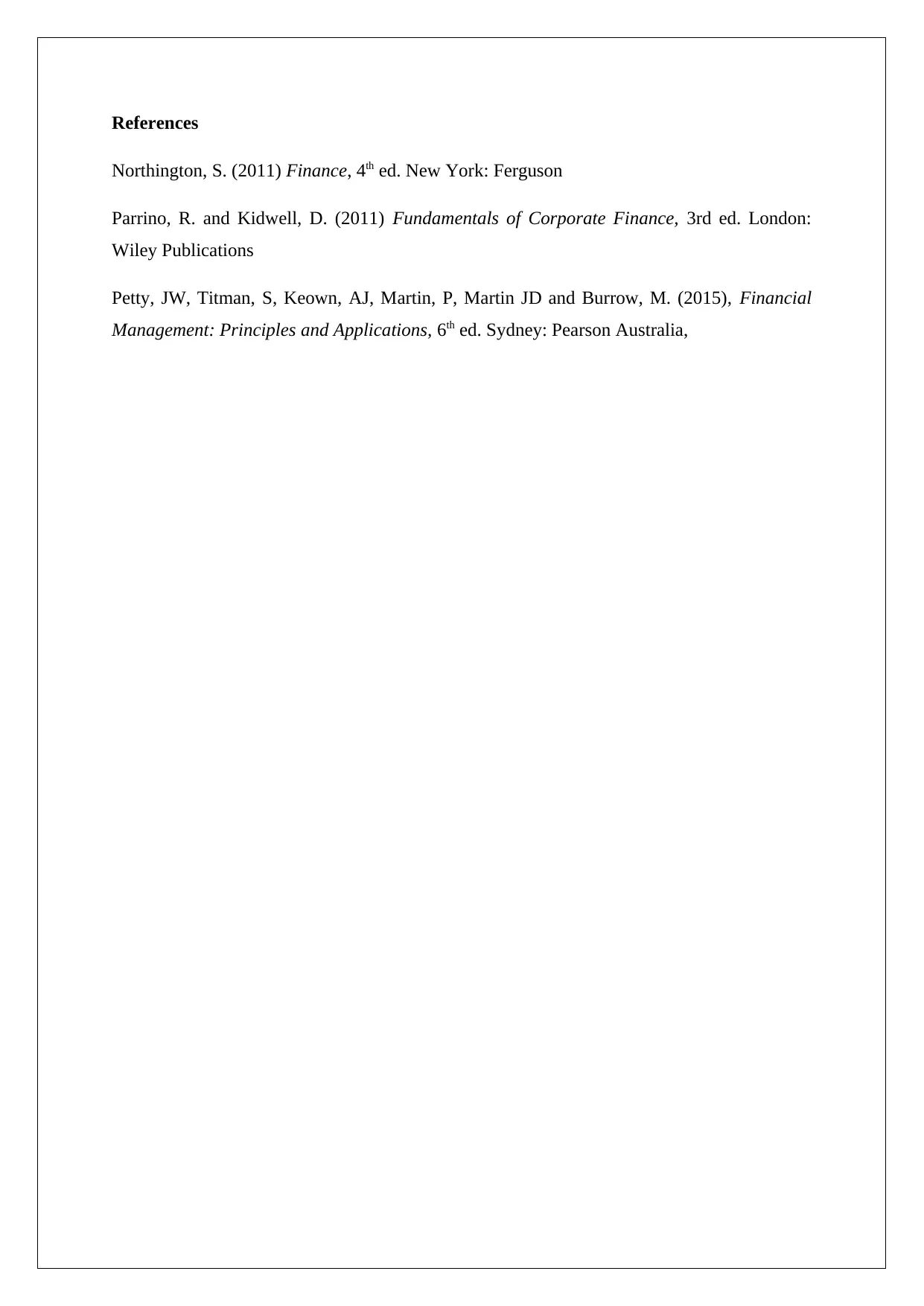
References
Northington, S. (2011) Finance, 4th ed. New York: Ferguson
Parrino, R. and Kidwell, D. (2011) Fundamentals of Corporate Finance, 3rd ed. London:
Wiley Publications
Petty, JW, Titman, S, Keown, AJ, Martin, P, Martin JD and Burrow, M. (2015), Financial
Management: Principles and Applications, 6th ed. Sydney: Pearson Australia,
Northington, S. (2011) Finance, 4th ed. New York: Ferguson
Parrino, R. and Kidwell, D. (2011) Fundamentals of Corporate Finance, 3rd ed. London:
Wiley Publications
Petty, JW, Titman, S, Keown, AJ, Martin, P, Martin JD and Burrow, M. (2015), Financial
Management: Principles and Applications, 6th ed. Sydney: Pearson Australia,
⊘ This is a preview!⊘
Do you want full access?
Subscribe today to unlock all pages.

Trusted by 1+ million students worldwide
1 out of 6
Related Documents
Your All-in-One AI-Powered Toolkit for Academic Success.
+13062052269
info@desklib.com
Available 24*7 on WhatsApp / Email
![[object Object]](/_next/static/media/star-bottom.7253800d.svg)
Unlock your academic potential
Copyright © 2020–2025 A2Z Services. All Rights Reserved. Developed and managed by ZUCOL.





